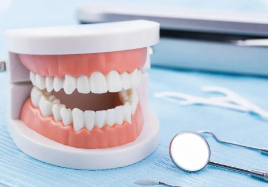Misunderstandings of adult orthodontics orthodontics Part 2
Misunderstandings of adult orthodontics orthodontics Part 2
Misunderstanding 11 The greater the orthodontic force, the faster the teeth move;
Small orthodontic force, no pain, slow or no tooth movement
Tooth movement is a slow physiological movement in which bone cells participate in the reconstruction. It is different from the physical and mechanical phenomena in the macroscopic world.
It does not mean that the greater the force, the faster the speed. In fact, a small force can start the tooth movement, but too much force will stop the movement or bring many side effects.
Extremes lead to opposites, and correction cannot exceed physiological limits. During the correction period, as long as the interval between follow-up visits is shortened and the visits to the doctor are more frequent,
the progress can be accelerated and the course of treatment can be shortened.
Misunderstanding 12 During the correction period, as long as the interval between follow-up visits is shortened and the visits are more frequent, the progress can be accelerated and the course of treatment can be shortene.
Tooth movement is a slow physiological movement, with an average movement of up to 1mm a month. If the teeth and periodontal tissue lose time to rest due to frequent follow-up visits,
it may bring irreversible adverse consequences. Orthodontics cannot be counterproductive, and physiological laws must be respected.
Misunderstanding 13 Severe periodontitis cannot be corrected
Many orthodontists are intimidated by this. Severe periodontitis often has obvious pathological tooth displacement or loosening,
but orthodontics is also treating periodontal disease at the same time. The application of orthodontic force within the biological limit will not make periodontal disease worse,
but will improve the condition. Untreated or controlled periodontitis cannot be corrected, but stable periodontitis can be corrected.
This is a treatment that can only be completed by the cooperation of different professional physicians, and it is a test for physicians.
Misunderstanding 14: Wearing braces will corrode the tooth surface
The appliance is bonded to the tooth surface. At present, the special enamel adhesive is used in the oral cavity.
It is fixed on the cleaned tooth surface for about two years. During the treatment, the appliance may fall off due to external force and be bonded repeatedly.
It will also not affect the tooth surface. This is a very mature bonding technology used in dentistry for more than 40 years, so there is no need to worry.
The so-called corrosion is actually mainly due to the demineralization of the enamel on the tooth surface around the brackets caused by poor oral hygiene.
Poor oral hygiene is the culprit, and orthodontics should not be blamed.
Misunderstanding 15 Orthodontics can only solve dental problems
Orthodontics can change the position of the teeth, and the interdependence of the lips and teeth can then change the front and rear positions of the lips,
resulting in changes in the prominence of the soft tissue profile. In addition, changes in the relationship between the lips and teeth can also bring about changes in the aesthetics of smiles.
Therefore, orthodontics not only solves dental problems, but often brings beauty to a large extent, and even achieves unexpected results similar to cosmetic surgery.

Misunderstanding 16 Orthodontics can slim or change the shape of the face
The work of orthodontists is to move the teeth, especially the position of the front teeth changes, the nearby alveolar bone also undergoes a certain degree of remodeling,
the front-to-back position of the lips and the relationship between the lips and teeth will also change, resulting in changes in the appearance of the face below the nose ,
rather than changes in face width or other facial features. Seeking truth from facts, we must correctly view the contribution of orthodontists.
Misunderstanding 17 Orthodontics will affect the child's height development
Some parents worry that many diets will be taboo during the orthodontic period, which will affect the child's development, but in fact there is no absolute taboo for orthodontics,
the key is to pay attention to the method. Correction is the process of alveolar bone remodeling, and the results of the treatment will be related to the growth and development of the upper and lower jaws,
but the correction itself will not affect the growth of children's height. Orthodontics takes a long time and often goes through the rapid growth stage of children. Parents will inevitably worry.
Misunderstanding 18 Adult orthodontics are prone to rebound
Orthodontics will relapse to varying degrees after a period of time, but the recurrence has nothing to do with the age at which the orthodontics started. In fact, the impact of puberty growth
and development on the stability of orthodontics cannot be ignored. Recurrence is inevitable, and clinically professional orthodontists will reduce the degree of recurrence through various methods.
Misunderstanding 19 As long as you are a dental expert, you can do orthodontics
Stomatology is divided into different majors. Only at the postgraduate stage can one study orthodontics systematically, receive standardized professional training and practice continuously in the training.
Therefore, experts in other oral professions cannot perform professional orthodontics, but must be done by orthodontic specialists , many developed countries implement the system of specialist doctors and legislate to protect them.
Misunderstanding 20 Many patients like to compare treatment plans, pain feelings, tooth movement speed, treatment courses and even costs with others
Everyone is a different individual, and correction should be a personalized treatment for different specific situations. In addition, the individual differences in treatment responses also reflect the practical requirements of stomatology,
so corrections can only be made for different individuals, and horizontal comparisons are inappropriate.



